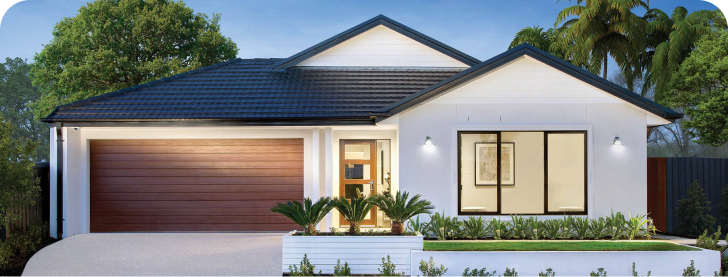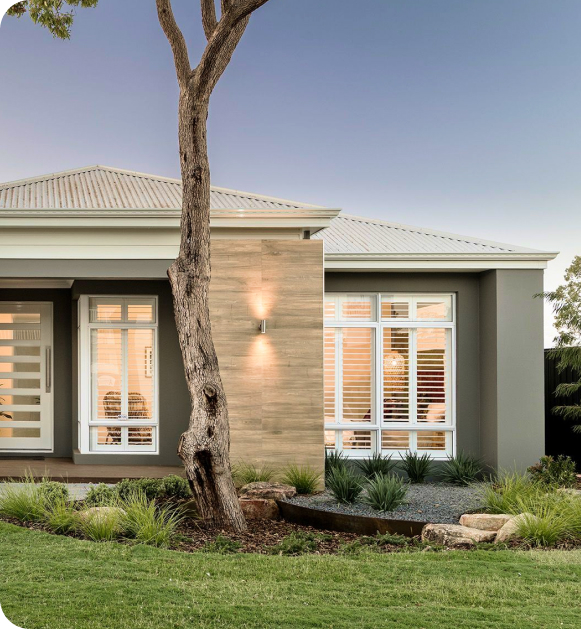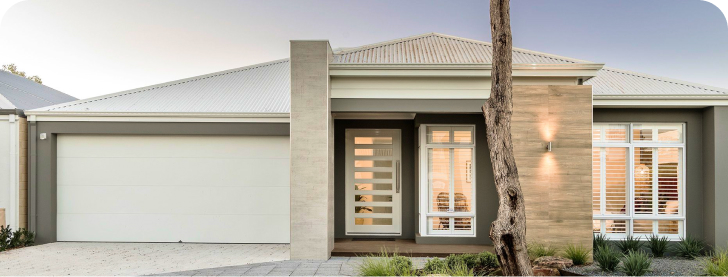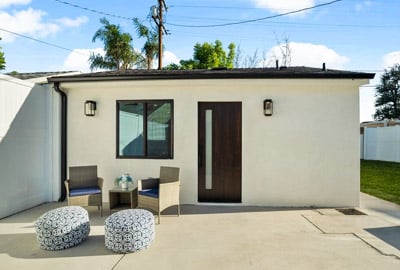
Building an accessory dwelling unit (ADU) means building a secondary dwelling unit on the same property lot as your primary residence. Like the main house, these separate living spaces typically include a food preparation area, a place for sleeping, and a bathroom, all of which fit into the downsized square footage of tiny homes.
Recently, backyard cottages have been in increased demand among property owners. The reasons are that accessory dwelling units are an ideal solution for hosting friends, creating additional living space for aging parents or adult children, or opening up a source of passive income that can cover monthly mortgage payments. Increased property value is also desirable for those who plan to earn extra cash on resale value.
If you want to learn more about the benefits of ADU construction, read this article further!
An opportunity to earn passive income is one of the top reasons why homeowners decide on building an ADU in the first place. To adopt an accessory dwelling unit for giving it out for rent, make sure this unit has enough space and its own entrance, as well as amenities for leading a day-to-day life.
ADU construction created for rent is a win-win situation for both the property owners and the tenants. As the first ones receive regular additional income, thanks to which they can effortlessly pay for the communal bills, decrease their mortgage burden, or save money for big purchases and travel.
In turn, tenants obtain more opportunities for low-cost housing. They can have their own space without long-term lease obligations that don't suit everyone.
An accessory dwelling unit is a perfect solution when it comes to aging family members, postgraduate young adults, and young parents who cannot afford their own houses so far.
The average cost of building a house is $400,000, not to mention that it takes a lot of time. So, what if you've just graduated from college, are burdened with tens of thousands of dollars in debt, and have no existing property to live on?
The thing is, when you live alone or together with your spouse, you don't need much space to overpay for. For example, a moderate 750 sq. ft. ADU with all amenities will cost your family $100,000–150,000 to build, which is around three times cheaper than a house. And after you move out of this ADU, it can bring forth several benefits for your family, so it pays off anyway.
When it comes to aging family members, saving money is obvious. As assisted living may cost up to $7,000 per month, in the long run (two years and more), building an ADU on the same lot turns out to cost the same while providing more psychological and practical benefits.
ADUs are also additional living spaces for college students or young families to rent, as you don't have to pay for several months of the lease at once.
Besides rental income, the benefits of building an accessory dwelling unit (ADU) encompass such investment opportunities as improving your overall property price. If you buy a piece of property to build a primary residence on it and then sell it again, accessory dwelling units make your deal even more profitable.
On average, accessory dwelling units can increase resale value by 20–30%! All of these are because wise buyers find alluring ADU's benefits like extra versatile space and potential rental income as well.
Because of the versatility of ADU types, there are many ways you can utilize the ADU space for living. These include:
Such self-sufficient construction provides comfort and all the amenities indispensable for daily life. Both your elderly relatives and, for example, older teenagers who need an independent space can live separately but at the same time within a few feet of each other.
If your existing property lot doesn't allow room for a large-scale building, you can turn part of your garage into an ADU, create an ADU on the second floor of your garage, or transform your attic into a small but comfy dwelling space. Such spaces are ideal for people who prefer to live with minimalism. But if this is not your case, then you can arrange a temporary shelter there for yourself and other family members who want to relax alone.
A guest house is a type of construction that allows the owners to not crowd into one house every time guests come to them. So you can enjoy each other's company without violating personal boundaries.
And the biggest plus is that an ADU can be used for all of these goals, one after another. It makes your living conditions much more flexible than just living in a traditional house.
Some people are rightfully concerned about how building an ADU would reflect on their taxes. The thing is, when your property value increases, it does bring forth a rise in taxes. To reassure them, we have to mention that when it comes to ADUs, there are no drastic changes in the annually paid sum. Typically, it will add no more than 1–1.5 percent of the ADU cost to your taxing amount.
More so, there are also a few advantages that an ADU owner gets. For instance, places with housing shortages sometimes offer tax benefits for those who build ADUs and rent them out. Also, you can resort to tax deductions when it comes to ADUs, home remodeling, or putting your rental ADU ads out there.
Accessory dwelling units can become a means of affordable housing for some of your family members. United on one piece of land, your expanded family can share household items, help out in difficult situations, and spend more quality time together.
How exactly can an ADU be helpful for the owners of residential properties in these matters?
The eco-friendliness of living space is an important factor for many eco-aware property owners. And here is some good news for you: during accessory dwelling units' construction, you usually use way fewer materials due to their smaller size, which negatively affects the problem of deforestation.
More so, when downsizing to an accessory dwelling unit, many ADU residents prefer to reduce their waste of electricity and water resources as well as install more energy-efficient HVAC systems.
In addition to everything else, accessory dwelling units are vacant spaces that you can use for anything you deem appropriate.
Thus, you can turn a detached ADU space into:
All in all, an ADU is a versatile place you can organize fully according to your personal preferences, with the potential to generate additional income in the future.
Isn't it a pleasure to take a slow stroll along the aesthetically appealing streets of your cozy settlement on peaceful, lazy Sundays?
An ADU is more than just a practical space. It's a design project that can harmoniously blend with the surrounding neighborhood architecture. Modern geometrical and minimalistic design or a rustic fairytale look?
Professional architects and designers will help you plan the layout and interior of the ADU of your dreams!
Everyone has different living situations. For example, when moving to another city, retired people cannot always afford to build a new house. Moreover, some don't need so much space for two or can't afford to pay for unjustly high communal bills.
However, about 75% of the offers on the real estate market are occupied by single-family houses. This leads to the unavailability of affordable housing for a large percentage of people.
In turn, ADUs provide an efficient solution to this issue. As adults, children can build a cheaper housing option on the town lot to accommodate their aging parents. Or other homeowners can rent out their ADUs to provide homes to people with low incomes, thereby receiving passive income themselves.
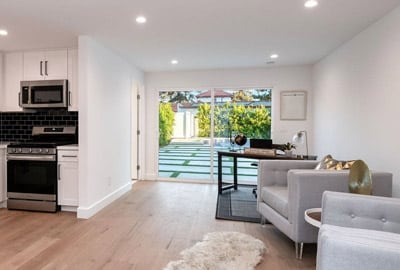
It may sound strange, but an ADU provides an extra level of security. And the reason for this is that another structure located at the other end of the territory of your site, as well as the person in it, ensures more extensive overview coverage.
Thus, for example, if a burglar decides to break into your house, an ADU resident has more chances to notice it and call the police in time.
ADUs are divided into attached and detached ADUs, internal and external ADUs, conversions, and new constructions. Attached ADUs share a wall with the main house, while detached ones stand completely separate. Internal ADUs are those that homeowners make inside the main residence. Conversions are ADUs that you build from an already existing structure, predominantly a garage.
According to building rules and regulations, ADUs cannot exceed 1000–1200 sq. ft. and be less than 150 sq. ft. Also, junior ADUs can only reach 500 sq. ft. in terms of size.
The best size depends on your goals and your individual needs for space. But quite popular are ADUs slightly under 750 sq. ft. They are easier and faster to build, are not too crampy, and are subject to fewer building restrictions and smaller impact fees than bigger ones.
ADU is a kind of investment that is more palpable than just money in a bank. First, renting it out will bring you sufficient income every month. Also, you receive a great opportunity to resell your property, which increases its value. But here, the ADU virtues don't end. Because if you build an ADU for yourself, you can improve your living conditions, expand your social life by accommodating friends and relatives there, and create a small haven for yourself to chill or work in.



